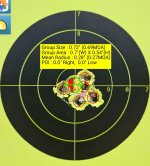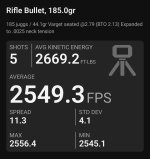I just discovered something about bullet seating and "reverse" setback or "bullet jump":
When I mandrel expand my cases to .002 neck tension, and then seat my bullet with a crimp (Lee Factory die crimp), the bullet jumps forward. 005 (and higher) after I close (slam) the bolt on my AR-10!
So, all my seating tests have been in vain.
I tested several bullets this morning, all starting with a COAL of 2.8... then, after chambering the rounds, I removed them from the chamber and remeasured- all seating depths changed drastically to 2.805, 2.81, and some even higher.
I may have to change my neck tension to. 004 because the ones I tried at .003 also jumped out further.
I even gently loaded a few to make sure the chamber wasn't grabbing on extraction, and it's not.
Slamming the bolt home causes my bullet seating to change drastically at .002 and. 003 even with the crimp.
So, if I increase my neck tension to .004, which many people online recommend for semi's, then it'll take more force to seat the bullet which comes with its own slight degradation in run out and concentricity... right?
What do you guys think about all of this?
When I mandrel expand my cases to .002 neck tension, and then seat my bullet with a crimp (Lee Factory die crimp), the bullet jumps forward. 005 (and higher) after I close (slam) the bolt on my AR-10!
So, all my seating tests have been in vain.
I tested several bullets this morning, all starting with a COAL of 2.8... then, after chambering the rounds, I removed them from the chamber and remeasured- all seating depths changed drastically to 2.805, 2.81, and some even higher.
I may have to change my neck tension to. 004 because the ones I tried at .003 also jumped out further.
I even gently loaded a few to make sure the chamber wasn't grabbing on extraction, and it's not.
Slamming the bolt home causes my bullet seating to change drastically at .002 and. 003 even with the crimp.
So, if I increase my neck tension to .004, which many people online recommend for semi's, then it'll take more force to seat the bullet which comes with its own slight degradation in run out and concentricity... right?
What do you guys think about all of this?



